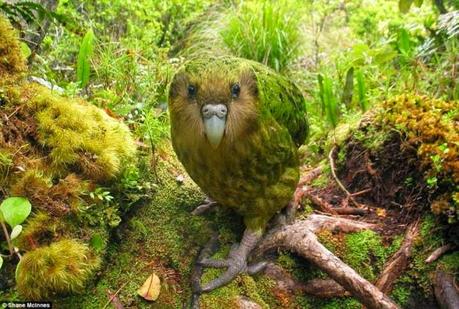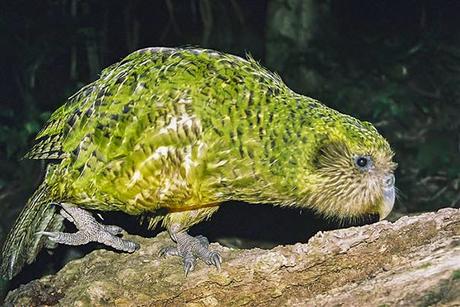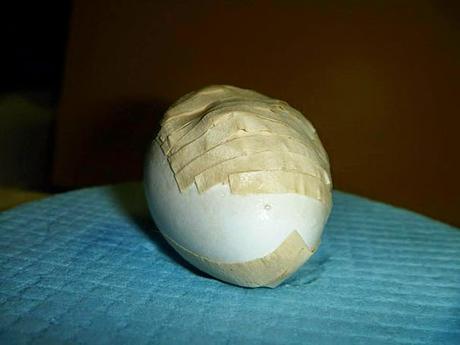 Its Latin name translates to something like
“owl-face soft-feather.” It does possess very soft feathers and a prominent
facial disc of fine feathers, like an owl. It also sometimes goes by the name
of owl parrot or night parrot. The birds
live in New Zealand, an island country which had virtually no mammals living on
it for millions of years. It was a place inhabited by birds and reptiles.
It is
the ‘Kakapo’ [also called Night parrot, owl parrot] a large,flightless,
nocturnal, ground-dwelling parrot of the super-family Strigopoidea endemic to
New Zealand. It has
finely blotched yellow-green plumage, a distinct facial disc of sensory,
vibrissa-like feathers, a large gray beak, short legs, large feet, and wings
and a tail of relatively short length. A combination of traits make it unique
among its kind; it is the world's only flightless parrot, the heaviest
parrot. Its anatomy typifies the tendency of bird
evolution on oceanic islands, with few predators and abundant food. Like many other New Zealand bird species, the
kakapo was historically important to the Māori, the indigenous people of New
Zealand, appearing in many of their traditional legends and folklore. It was
hunted and used as a resource by Māori, both for its meat as a food source and
for its feathers, which were used to make highly valued pieces of clothing. It
was also sometimes kept as a pet.
Its Latin name translates to something like
“owl-face soft-feather.” It does possess very soft feathers and a prominent
facial disc of fine feathers, like an owl. It also sometimes goes by the name
of owl parrot or night parrot. The birds
live in New Zealand, an island country which had virtually no mammals living on
it for millions of years. It was a place inhabited by birds and reptiles.
It is
the ‘Kakapo’ [also called Night parrot, owl parrot] a large,flightless,
nocturnal, ground-dwelling parrot of the super-family Strigopoidea endemic to
New Zealand. It has
finely blotched yellow-green plumage, a distinct facial disc of sensory,
vibrissa-like feathers, a large gray beak, short legs, large feet, and wings
and a tail of relatively short length. A combination of traits make it unique
among its kind; it is the world's only flightless parrot, the heaviest
parrot. Its anatomy typifies the tendency of bird
evolution on oceanic islands, with few predators and abundant food. Like many other New Zealand bird species, the
kakapo was historically important to the Māori, the indigenous people of New
Zealand, appearing in many of their traditional legends and folklore. It was
hunted and used as a resource by Māori, both for its meat as a food source and
for its feathers, which were used to make highly valued pieces of clothing. It
was also sometimes kept as a pet.
 The
kakapo is critically endangered; as of March 2014, with an
additional six from the first hatchings
since 2011, the total known population is only 126
living individuals, as reported by the Kakapo Recovery programme, most of which
have been given names. The Programme
states that surviving kakapo are kept on
three predator-free islands, Codfish (Whenua Hou), Anchor and Little Barrier
islands, where they are closely monitored.
The New Zealand government is
willingly providing the use of these islands to kakapo conservation.
The flightless
birds use their short wings for balance and support rather than flapping. They can
climb tall trees and use their wings to help “parachute” to the forest
floor. Kakapos freeze when startled. One
of their defenses is to freeze and hope to blend into the background when
danger is near. The kakapo has a well-developed sense of smell, useful in its
nocturnal lifestyle. It also has what’s described as a musty-sweet odor. This
likely helps kakapos find each other in the forest; unfortunately, it helps
introduced mammalian predators find them, too.
Sometime back the
World wide web was abuzz with the long-shot success story of Lisa One, a kakapo
parrot chick whose life was saved by New Zealand conservationists after her
mother Lisa accidentally crushed her egg. The task was arduous considering the
delicate nature. Senior kakapo ranger
Jo Ledington had to tape the shell of a partially crushed kakapo egg back
together and allow the chick within to mature and hatch naturally. They
succeeded by using, of all thing, masking tape.
The
kakapo is critically endangered; as of March 2014, with an
additional six from the first hatchings
since 2011, the total known population is only 126
living individuals, as reported by the Kakapo Recovery programme, most of which
have been given names. The Programme
states that surviving kakapo are kept on
three predator-free islands, Codfish (Whenua Hou), Anchor and Little Barrier
islands, where they are closely monitored.
The New Zealand government is
willingly providing the use of these islands to kakapo conservation.
The flightless
birds use their short wings for balance and support rather than flapping. They can
climb tall trees and use their wings to help “parachute” to the forest
floor. Kakapos freeze when startled. One
of their defenses is to freeze and hope to blend into the background when
danger is near. The kakapo has a well-developed sense of smell, useful in its
nocturnal lifestyle. It also has what’s described as a musty-sweet odor. This
likely helps kakapos find each other in the forest; unfortunately, it helps
introduced mammalian predators find them, too.
Sometime back the
World wide web was abuzz with the long-shot success story of Lisa One, a kakapo
parrot chick whose life was saved by New Zealand conservationists after her
mother Lisa accidentally crushed her egg. The task was arduous considering the
delicate nature. Senior kakapo ranger
Jo Ledington had to tape the shell of a partially crushed kakapo egg back
together and allow the chick within to mature and hatch naturally. They
succeeded by using, of all thing, masking tape.
 Preserving the
kakapo is important not just to maintain New Zealand’s biodiversity, but
because they’re truly extraordinary birds. Not only are they the world’s
heaviest parrot at 2-4kg, they are also possibly the longest-lived bird in the
world, with a life expectancy of 95 years – and some have even lived to 120.
With regards – S.
Sampathkumar
13th Feb
2015.
PS :
facts collated from various sources including Kakapo Recovery programme;
wired.com; boredpanda.com and www.australiangeographic.com.au
Preserving the
kakapo is important not just to maintain New Zealand’s biodiversity, but
because they’re truly extraordinary birds. Not only are they the world’s
heaviest parrot at 2-4kg, they are also possibly the longest-lived bird in the
world, with a life expectancy of 95 years – and some have even lived to 120.
With regards – S.
Sampathkumar
13th Feb
2015.
PS :
facts collated from various sources including Kakapo Recovery programme;
wired.com; boredpanda.com and www.australiangeographic.com.au

